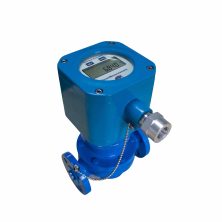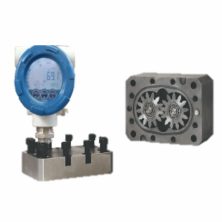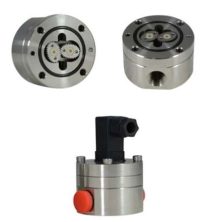Featured Products
Positive Displacement Flow Meters Overview
Positive displacement flowmeters, or PD meters, feature two precisely machined intermeshing gears which rotate within a measuring chamber to determine the volumetric liquid flow rate by counting the number of the gears’ rotations. Positive displacement flow meters function in much the same manner as a positive displacement pump with the exception being that in the Positive Displacement pump the gears drive the fluid media, whereas in the PD flowmeter the fluid media drives the gears. The positive displacement meter technique is one of the oldest flow measurement technologies in existence and has been in use for over one hundred years. During that time, many different varieties of the PD meter have been developed including versions that feature round gears, oval gears, lobe gears, helical gears and nutating disc rotating elements. These meters are all characterized by high accuracy (up to ±0.1% of reading), good repeatability (up to 0.05% of reading), wide turndown ratios of up to 100:1, and the ability to maintain this level of performance for both high viscosity and changing-viscosity fluid media.
Why Choose a PD Flow Meter?
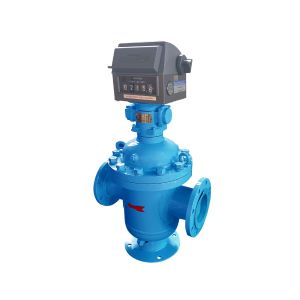
One common reason for using the positive displacement flow meter is that it can function without power. By outfitting the meter with a mechanical register, totalized flows may be accurately monitored in virtually any engineering unit desired by the end-user without the need to run power to the meter. This is ideal for applications where the meter must be installed in a remote location where power is not available. Positive displacement flow meters are available in sizes from ⅛” to 12 inches or more. Operation turndowns can be as high as 100:1, although ranges of 15:1 or lower are much more common. Slippage between the flowmeter components is reduced and metering accuracy is therefore increased as the viscosity of the process fluid flow increases. Therefore, positive displacement flow meters are excellent for highly viscous fluids such as oils and fats.
Most flowmeters are sensitive to turbulence, which means that a certain amount of straight, rigid pipe must be installed both upstream and downstream of the meter in order to reduce turbulence and accurately measure flow (Download PDF). Positive Displacement meters do not have this requirement. If necessary, an elbow or reducer bushing may be placed directly at the meter inlet with no impact on the meter’s accuracy.
Advantages of Using PD Flow Meters
Positive Displacement Flow meters being one of the oldest, if not the oldest flow meter technique, come in many different styles. The most popular ones are described on our Positive Displacement Measuring Principle page.
SmartMeasurement offers a range of positive displacement meters including the most popular styles of PD flowmeters in service today which include oval/lobe gear type, bi-rotor or helix gear types, and oval gear pd meters.
Although slippage through the positive displacement flow meters decreases (that is, accuracy increases) as fluid flow viscosity increases, pressure drop through the meter also rises. Consequently, the maximum (and minimum) flow capacity of the flowmeter is decreased as viscosity increases. The higher the viscosity, the less slippage and the lower the measurable flow rate. As the viscosity decreases, the low-flow performance of the meter deteriorates. The maximum allowable pressure drop across the meter constrains the maximum operating flow in high-viscosity services.
Features of Positive Displacement Flow Meters
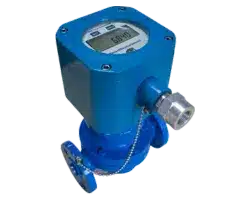
Positive Displacement (PD) Flow Meters are engineered with a unique set of features that make them highly effective for precise liquid flow measurement. One of the most significant features is exceptional accuracy. PD flow meters can measure the flow of liquids with precision, even in low-flow conditions, making them ideal for applications where exact measurements are crucial.
Another key feature is their ability to handle a wide range of viscosities. Whether the liquid is thin like water or thick like syrup, PD flow meters can maintain accurate readings without being affected by the fluid’s consistency. This versatility ensures they are suitable for various industries, including oil and gas, chemical processing, and food and beverage manufacturing.
PD flow meters are also known for their durability and reliability. Constructed from robust materials, these meters can withstand harsh environments and continuous operation without compromising performance. This durability translates into longer service life and reduced maintenance costs.
In addition, PD flow meters offer direct volumetric measurement, which eliminates the need for complex calculations or compensations. The mechanical operation of these meters ensures that every rotation or displacement corresponds to a specific volume, providing straightforward and reliable data.
Lastly, PD flow meters are designed with ease of installation and use in mind. Their simple mechanical design means they can be installed in various orientations without losing accuracy, and they require minimal upkeep, making them a cost-effective choice for many businesses.
Key Applications
Positive displacement flow meters flow meters from SmartMeasurement have been successfully installed in a wide variety of industries and applications including:
Oil & Gas
In the oil and gas industry, Positive Displacement (PD) Flow Meters are essential for accurately measuring the flow of crude oil, refined products, and natural gas liquids. Their ability to handle a wide range of viscosities makes them ideal for applications such as custody transfer, where precise measurement is critical to ensure fair trade and compliance with industry regulations.
Chemical & Petrochemical
PD flow meters are extensively used in the chemical and petrochemical industries due to their capability to accurately measure highly viscous and corrosive fluids. These meters are vital for monitoring and controlling the flow of various chemicals during processing, ensuring that production remains consistent and safe. Their robust design allows them to operate effectively in harsh environments, maintaining accuracy even with challenging liquids.
Fiscal Metering
In fiscal metering, where financial transactions are directly tied to the volume of liquid measured, PD flow meters play a crucial role. They provide the high precision required for billing purposes in industries like oil and gas, ensuring that the volume of product exchanged is measured accurately, minimizing disputes, and ensuring compliance with legal standards.
Fuel Transportation
For fuel transportation, PD flow meters are indispensable in measuring the volume of fuel transferred from one point to another, such as from a tanker to storage or from storage to a vehicle. Their reliability and accuracy ensure that every drop is accounted for, making them a trusted tool in the logistics of fuel distribution.
Liquid Storage Tanks
PD flow meters are often installed in liquid storage tanks to monitor the inflow and outflow of liquids. This application is particularly common in industries where precise inventory management is essential, such as in oil refineries or chemical plants. Their ability to measure large volumes accurately over extended periods ensures that storage levels are correctly tracked and maintained.
Food & Beverage
In the food and beverage industry, PD flow meters are used to measure ingredients, control mixing processes, and ensure consistent product quality. Their ability to handle various liquid viscosities, from water to syrups, makes them versatile for applications such as dairy processing, brewing, and bottling, where precision and hygiene are paramount.
Pharmaceutical
Pharmaceutical applications require the highest levels of accuracy and consistency, which is why PD flow meters are often used in the production of liquid medicines, vaccines, and other pharmaceutical products. Their ability to deliver precise measurements of active ingredients and solvents ensures that products meet strict quality and safety standards.
Marine & Shipping
In the marine and shipping industries, PD flow meters are crucial for monitoring the fuel consumption of ships and ensuring the accurate transfer of fuel and other liquids between vessels and storage facilities. Their robust design allows them to withstand the harsh conditions of marine environments while providing reliable and accurate measurements.
Theories of Flow Meter Operation


